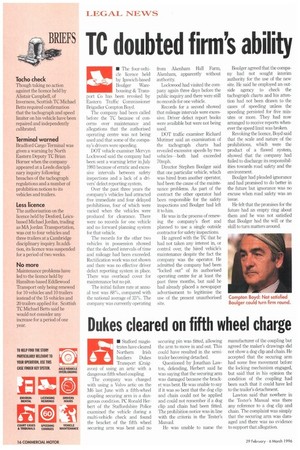TC doubted firm's ability
Page 18

If you've noticed an error in this article please click here to report it so we can fix it.
es% • The four-vehi
cle licence held by Ipswich-based housing & Transport Co has been revoked by Eastern Traffic Commissioner Brigadier Compton Boyd.
The company had been called before the TC because of concerns over maintenance and allegations that the authorised operating centre was not being used and that some of the company's drivers were speeding.
DOT vehicle examiner Mervyn Lockwood said the company had been sent a warning letter in July 1993 because of erratic and excessive intervals between safety inspections and a lack of a drivers' defect reporting system.
Over the past three years the company's vehicles had attracted five immediate and four delayed prohibitions, four of which were varied when the vehicles were produced for clearance. There were no records for one vehicle and no forward planning system for that vehicle.
The records for the other two vehicles in possession showed that the declared intervals of time and mileage had been exceeded. Rectification work was not shown and there was no effective driver defect reporting system in place. There was overhead cover for maintenance but no pit.
The initial failure rate at annual test was 88%, compared with the national average of 33%. The company was currently operating from Akenham Hall Farm, Akenham, apparently without authority.
Lockwood had visited the company again three days before the public inquiry and there were still no records for one vehicle.
Records for a second showed that mileage intervals were excessive. Driver defect report books were available but were not being used.
DOT traffic examiner Richard Mutimer said an examination of the tachograph charts had revealed excessive speeds by two vehicles—both had exceeded 70mph.
Director Stephen Boulger said that one particular vehicle, which was hired from another operator, had been the cause of the maintenance problems. As part of the contract the other operator had been responsible for the safety inspections and Boulger had left it to him.
He was in the process of renewing the company's fleet and planned to use a single outside contractor for safety inspections.
He agreed with the TC that he had not taken any interest in, or control over, the hired vehicle's maintenance despite the fact the company was the operator. He admitted the company had been "locked out" of its authorised operating centre for at least the past three months, but said he had already placed a newspaper advertisement to legitimise the use of the present unauthorised site. Boulger agreed that the company had not sought interim authority for the use of the new site. He said he employed an outside agency to check the tachograph charts and his attention had not been drawn to the cases of speeding unless the speeding persisted for five minutes or more. They had now arranged to receive reports whenever the speed limit was broken.
Revoking the licence, Boyd said that the scale and nature of the prohibitions, which were the product of a flawed system, showed that the company had failed to discharge its responsibilities towards road safety and the environment Boulger had pleaded ignorance and had promised to do better in the future but ignorance was no excuse when road safety was an issue.
He felt that the promises for the future had an empty ring about them and he was not satisfied that Boulger had the will or the skill to turn matters around.




































































































